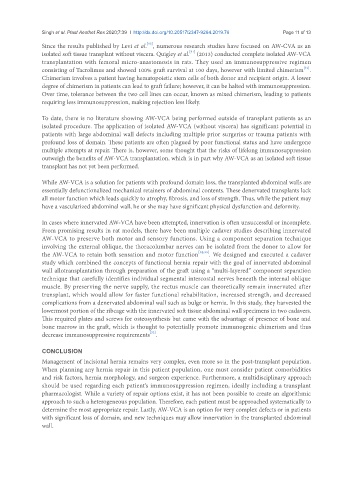Page 429 - Read Online
P. 429
Singh et al. Plast Aesthet Res 2020;7:39 I http://dx.doi.org/10.20517/2347-9264.2019.76 Page 11 of 13
[12]
Since the results published by Levi et al. , numerous research studies have focused on AW-CVA as an
[31]
isolated soft tissue transplant without viscera. Quigley et al. (2013) conducted complete isolated AW-VCA
transplantation with femoral micro-anastomosis in rats. They used an immunosuppressive regimen
[31]
consisting of Tacrolimus and showed 100% graft survival at 100 days, however with limited chimerism .
Chimerism involves a patient having hematopoietic stem cells of both donor and recipient origin. A lower
degree of chimerism in patients can lead to graft failure; however, it can be halted with immunosuppression.
Over time, tolerance between the two cell lines can occur, known as mixed chimerism, leading to patients
requiring less immunosuppression, making rejection less likely.
To date, there is no literature showing AW-VCA being performed outside of transplant patients as an
isolated procedure. The application of isolated AW-VCA (without viscera) has significant potential in
patients with large abdominal wall defects including multiple prior surgeries or trauma patients with
profound loss of domain. These patients are often plagued by poor functional status and have undergone
multiple attempts at repair. There is, however, some thought that the risks of lifelong immunosuppression
outweigh the benefits of AW-VCA transplantation, which is in part why AW-VCA as an isolated soft tissue
transplant has not yet been performed.
While AW-VCA is a solution for patients with profound domain loss, the transplanted abdominal walls are
essentially defunctionalized mechanical retainers of abdominal contents. These denervated transplants lack
all motor function which leads quickly to atrophy, fibrosis, and loss of strength. Thus, while the patient may
have a vascularized abdominal wall, he or she may have significant physical dysfunction and deformity.
In cases where innervated AW-VCA have been attempted, innervation is often unsuccessful or incomplete.
From promising results in rat models, there have been multiple cadaver studies describing innervated
AW-VCA to preserve both motor and sensory functions. Using a component separation technique
involving the external oblique, the thoracolumbar nerves can be isolated from the donor to allow for
the AW-VCA to retain both sensation and motor function [32,33] . We designed and executed a cadaver
study which combined the concepts of functional hernia repair with the goal of innervated abdominal
wall allotransplantation through preparation of the graft using a “multi-layered” component separation
technique that carefully identifies individual segmental intercostal nerves beneath the internal oblique
muscle. By preserving the nerve supply, the rectus muscle can theoretically remain innervated after
transplant, which would allow for faster functional rehabilitation, increased strength, and decreased
complications from a denervated abdominal wall such as bulge or hernia. In this study, they harvested the
lowermost portion of the ribcage with the innervated soft tissue abdominal wall specimens in two cadavers.
This required plates and screws for osteosynthesis but came with the advantage of presence of bone and
bone marrow in the graft, which is thought to potentially promote immunogenic chimerism and thus
[32]
decrease immunosuppressive requirements .
CONCLUSION
Management of incisional hernia remains very complex, even more so in the post-transplant population.
When planning any hernia repair in this patient population, one must consider patient comorbidities
and risk factors, hernia morphology, and surgeon experience. Furthermore, a multidisciplinary approach
should be used regarding each patient’s immunosuppression regimen, ideally including a transplant
pharmacologist. While a variety of repair options exist, it has not been possible to create an algorithmic
approach to such a heterogeneous population. Therefore, each patient must be approached systematically to
determine the most appropriate repair. Lastly, AW-VCA is an option for very complex defects or in patients
with significant loss of domain, and new techniques may allow innervation in the transplanted abdominal
wall.

